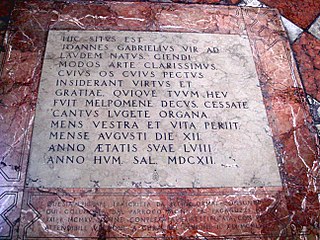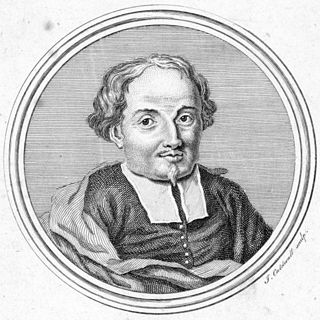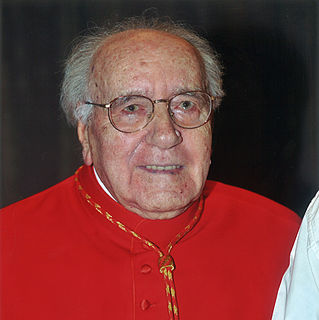Related Research Articles

Giovanni Pierluigi da Palestrina was an Italian Renaissance composer of sacred music and the best-known 16th-century representative of the Roman School of musical composition. He had a long-lasting influence on the development of church and secular music in Europe, especially on the development of counterpoint, and his work is considered the culmination of Renaissance polyphony.

In Western classical music, a motet is mainly a vocal musical composition, of highly diverse form and style, from high medieval music to the present. The motet was one of the pre-eminent polyphonic forms of Renaissance music. According to Margaret Bent, "a piece of music in several parts with words" is as precise a definition of the motet as will serve from the 13th to the late 16th century and beyond. The late 13th-century theorist Johannes de Grocheo believed that the motet was "not to be celebrated in the presence of common people, because they do not notice its subtlety, nor are they delighted in hearing it, but in the presence of the educated and of those who are seeking out subtleties in the arts".

Giovanni Gabrieli was an Italian composer and organist. He was one of the most influential musicians of his time, and represents the culmination of the style of the Venetian School, at the time of the shift from Renaissance to Baroque idioms.

The Vienna Boys' Choir is a choir of boy sopranos and altos based in Vienna, Austria. It is one of the best known boys' choirs in the world. The boys are selected mainly from Austria, but also from many other countries.
Anne Azéma is a French-born soprano, scholar, and stage director. She is currently artistic director of the Boston Camerata. She has been an important or leading singer of early music since 1993. She has created and directed programs for the Boston Camerata and is also noted as a music scholar. She is perhaps best known for performing music from the Middle Ages, lute songs from the Renaissance period, Baroque sacred music, Shaker song, and contemporary music theater. She is also a music educator and a researcher. She has performed in Japan, Germany, the US, Australia and elsewhere.

Heavenly Spheres is an a cappella choral album by the Studio de musique ancienne de Montréal under the direction of Christopher Jackson. Recorded in 1998, it features songs from the late 15th to early 16th century. It was awarded a Félix Award from the ADISQ and was nominated for the Juno Award for Classical Album of the Year – Vocal or Choral Performance in 2000.
Niels la Cour is a Danish composer.

Francesco Foggia was an Italian Baroque composer.
This is a list of notable events in music that took place in 1554.

Domenico Bartolucci was an Italian cardinal of the Catholic Church. He was the former director of the Sistine Chapel Choir and the Accademia Nazionale di Santa Cecilia, and was recognized in the field of music both as a director and a prolific composer. Considered among the most authoritative interpreters of Giovanni Pierluigi da Palestrina, Bartolucci led the Sistine Chapel Choir in performances worldwide, and also directed numerous concerts with the Choir of the Academy of Santa Cecilia, including a tour of the former Soviet Union.
The discography of Westminster Cathedral Choir includes many award-winning recordings, among them the 1998 Gramophone Award Record of the Year for Frank Martin's Mass for Double Choir and Ildebrando Pizzetti's Requiem.
Tristis est anima mea is the Latin phrase with which Matthew 26:38 starts. It is Tristis est anima mea (responsory), the second responsory of the Tenebrae for Maundy Thursday which was often set to music. It may also refer to:
Quatre motets pour un temps de pénitence, FP 97, are four sacred motets composed by Francis Poulenc in 1938–39. He wrote them on Latin texts for penitence, scored for four unaccompanied voices.
Missa Tu es Petrus is a parody mass for six voices (SSATBB) by Giovanni Pierluigi da Palestrina first printed in the Missarum, Liber 15 (1887) of Franz Xaver Haberl's edition. The eponymous model Tu es Petrus is one of three motets by Palestrina, all on the same text, intended “for the Feast of St. Paul and St. Peter” ; the other two are for 5 and 7 voices. In fact there are three Missae Tu es Petrus, the less well-known being a six-voice paraphrase mass on the gregorian antiphon posthumously published in Missarum, Liber 12 (1601), and a polychoral mass for 18vv of doubtful authenticity that like the other parody mass adapts the music of the same 1572 motet to the texts of the Ordinary of the Mass.
O magnum mysterium (1569) is a six-part motet by Giovanni Pierluigi da Palestrina, based on the responsorial chant of the same name, and was written for the celebration of Christmas. The piece is intended to express the joy and awe that was felt by the shepherds as they celebrated and worshiped the Christ-child in the manger on Christmas Eve. Palestrina took the text for this piece from the first half of the third and fourth Responsories of Matins on Christmas Day. The text has been set many times by numerous composers, such as Palestrina, Poulenc, Lauridsen, and Morales.

Sicut cervus is a motet for four voices by Giovanni Pierluigi da Palestrina. It sets the beginning of Psalm 42, Psalmus XLII in the Latin version of the Psalterium Romanum rather than the Vulgate Bible. The incipit is "Sicut cervus desiderat ad fontes" followed by a second part "Sitivit anima mea". It was published in 1604 in Motecta festorum, Liber 2, and has become one of Palestrina's most popular motets, regarded as a model of Renaissance polyphony, expressing spiritual yearning.
References
- ↑ Cummings, Robert. "Hodie Christus natus est". AllMusic. Retrieved 2017-12-24.
- ↑ "Hodie Christus natus est - Giovanni Pierluigi da Palestrina Song - BBC Music". BBC. Retrieved 2017-12-25.
- ↑ "Emmanuel Music - Francis Poulenc: Hodie Christus natus est - Program Notes". emmanuelmusic.org. Retrieved 2017-12-25.